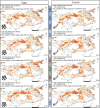Modeling Intraday Aedes-human exposure dynamics enhances dengue risk prediction
- PMID: 40055392
- PMCID: PMC11889163
- DOI: 10.1038/s41598-025-91950-9
Modeling Intraday Aedes-human exposure dynamics enhances dengue risk prediction
Abstract
Cities are the hot spots for global dengue transmission. The increasing availability of human movement data obtained from mobile devices presents a substantial opportunity to address this prevailing public health challenge. Leveraging mobile phone data to guide vector control can be relevant for numerous mosquito-borne diseases, where the influence of human commuting patterns impacts not only the dissemination of pathogens but also the daytime exposure to vectors. This study utilizes hourly mobile phone records of approximately 3 million urban residents and daily dengue case counts at the address level, spanning 8 years (2015-2022), to evaluate the importance of modeling human-mosquito interactions at an hourly resolution in elucidating sub-neighborhood dengue occurrence in the municipality of Rio de Janeiro. The findings of this urban study demonstrate that integrating knowledge of Aedes biting behavior with human movement patterns can significantly improve inferences on urban dengue occurrence. The inclusion of spatial eigenvectors and vulnerability indicators such as healthcare access, urban centrality measures, and estimates for immunity as predictors, allowed a further fine-tuning of the spatial model. The proposed concept enabled the explanation of 77% of the deviance in sub-neighborhood DENV infections. The transfer of these results to optimize vector control in urban settings bears significant epidemiological implications, presumably leading to lower infection rates of Aedes-borne diseases in the future. It highlights how increasingly collected human movement patterns can be utilized to locate zones of potential DENV transmission, identified not only by mosquito abundance but also connectivity to high incidence areas considering Aedes peak biting hours. These findings hold particular significance given the ongoing projection of global dengue incidence and urban sprawl.
Keywords: Aedes biting rates; Daytime exposure; Human movement; Spatial eigenvector mapping; Urban dengue transmission; Urban mobility.
© 2025. The Author(s).
Conflict of interest statement
Declarations. Competing interests: The authors declare no conflict of interest.
Figures













References
-
- Sattenspiel, L. & Lloyd, A. The Geographic Spread of Infectious Diseases: Models and Applications 5th edn. (Princeton University Press, 2009).
-
- Kraemer, M. U. G. et al. Progress and challenges in infectious disease cartography. Trends Parasitol.32, 19–29. 10.1016/j.pt.2015.09.006 (2016). - PubMed
-
- Yuan, Y. & Raubal, M. Extracting dynamic urban mobility patterns from mobile phone data. In Hutchison, D. et al. (eds.) Geographic Information Science, vol. 7478 of Lecture Notes in Computer Science 354–367 (Springer Berlin Heidelberg, Berlin, Heidelberg, 2012). 10.1007/978-3-642-33024-7_26
MeSH terms
Grants and funding
LinkOut - more resources
Full Text Sources
Medical

